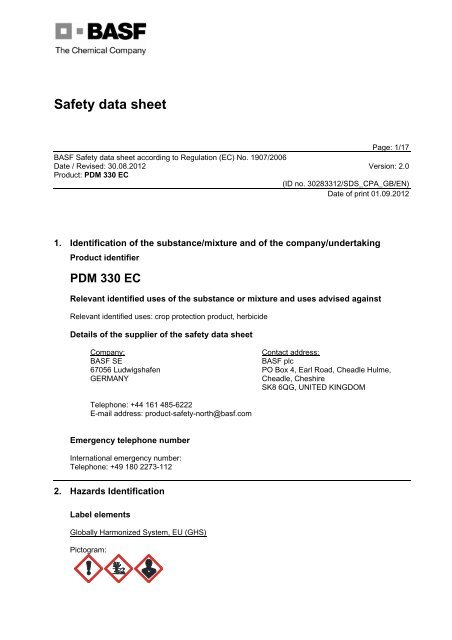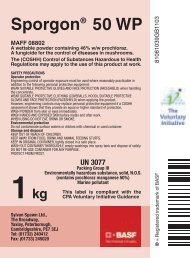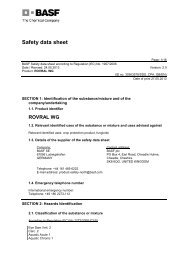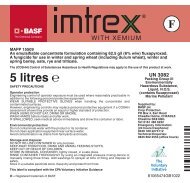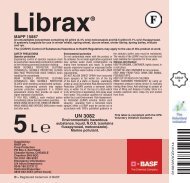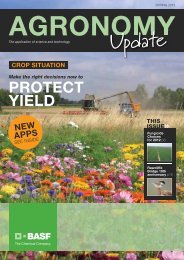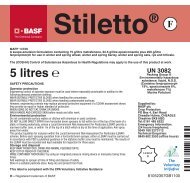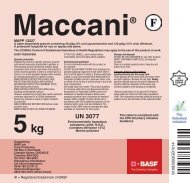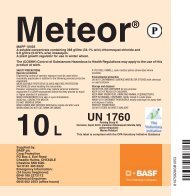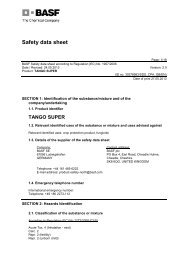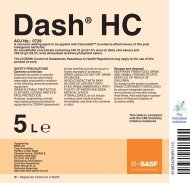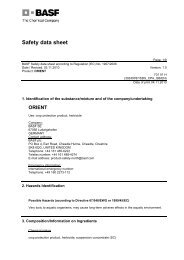PDM 330 EC - agriCentre UK - BASF
PDM 330 EC - agriCentre UK - BASF
PDM 330 EC - agriCentre UK - BASF
You also want an ePaper? Increase the reach of your titles
YUMPU automatically turns print PDFs into web optimized ePapers that Google loves.
Safety data sheet<br />
Page: 1/17<br />
<strong>BASF</strong> Safety data sheet according to Regulation (<strong>EC</strong>) No. 1907/2006<br />
Date / Revised: 30.08.2012 Version: 2.0<br />
Product: <strong>PDM</strong> <strong>330</strong> <strong>EC</strong><br />
(ID no. 30283312/SDS_CPA_GB/EN)<br />
Date of print 01.09.2012<br />
1. Identification of the substance/mixture and of the company/undertaking<br />
Product identifier<br />
<strong>PDM</strong> <strong>330</strong> <strong>EC</strong><br />
Relevant identified uses of the substance or mixture and uses advised against<br />
Relevant identified uses: crop protection product, herbicide<br />
Details of the supplier of the safety data sheet<br />
Company:<br />
<strong>BASF</strong> SE<br />
67056 Ludwigshafen<br />
GERMANY<br />
Contact address:<br />
<strong>BASF</strong> plc<br />
PO Box 4, Earl Road, Cheadle Hulme,<br />
Cheadle, Cheshire<br />
SK8 6QG, UNITED KINGDOM<br />
Telephone: +44 161 485-6222<br />
E-mail address: product-safety-north@basf.com<br />
Emergency telephone number<br />
International emergency number:<br />
Telephone: +49 180 2273-112<br />
2. Hazards Identification<br />
Label elements<br />
Globally Harmonized System, EU (GHS)<br />
Pictogram:
Page: 2/17<br />
<strong>BASF</strong> Safety data sheet according to Regulation (<strong>EC</strong>) No. 1907/2006<br />
Date / Revised: 30.08.2012 Version: 2.0<br />
Product: <strong>PDM</strong> <strong>330</strong> <strong>EC</strong><br />
(ID no. 30283312/SDS_CPA_GB/EN)<br />
Date of print 01.09.2012<br />
Signal Word:<br />
Danger<br />
Hazard Statement:<br />
H302<br />
H319<br />
H315<br />
H304<br />
H400<br />
H410<br />
EUH401<br />
Harmful if swallowed.<br />
Causes serious eye irritation.<br />
Causes skin irritation.<br />
May be fatal if swallowed and enters airways.<br />
Very toxic to aquatic life.<br />
Very toxic to aquatic life with long lasting effects.<br />
To avoid risks to human health and the environment, comply with the<br />
instructions for use.<br />
Precautionary Statements (Prevention):<br />
P280f<br />
Wear protective gloves and eye/face protection.<br />
P264<br />
Wash with plenty of water and soap thoroughly after handling.<br />
P270<br />
Do no eat, drink or smoke when using this product.<br />
Precautionary Statements (Response):<br />
P301 + P310<br />
IF SWALLOWED: Immediately call a POISON CENTER or<br />
doctor/physician.<br />
P331<br />
Do NOT induce vomiting.<br />
P302 + P352<br />
IF ON SKIN: Wash with plenty of soap and water.<br />
P305 + P351 + P338 IF IN EYES: Rinse cautiously with water for several minutes. Remove<br />
contact lenses, if present and easy to do. Continue rinsing.<br />
P361<br />
Remove/Take off immediately all contaminated clothing.<br />
P391<br />
Collect spillage.<br />
P<strong>330</strong><br />
Rinse mouth.<br />
P332 + P313<br />
If skin irritation occurs: Get medical advice/attention.<br />
Precautionary Statements (Disposal):<br />
P501<br />
Dispose of contents/container to hazardous or special waste collection<br />
point.<br />
Labeling of special preparations (GHS):<br />
May produce an allergic reaction. Contains: PENDIMETHALIN<br />
According to Regulation (<strong>EC</strong>) No 1272/2008 [CLP]<br />
Hazard determining component(s) for labelling: PENDIMETHALIN, SOLVENT NAPHTHA<br />
According to Directive 67/548/E<strong>EC</strong> or 1999/45/<strong>EC</strong><br />
Classification/labelling in accordance with <strong>UK</strong> regulations.<br />
Hazard symbol(s)<br />
Xn<br />
Harmful.<br />
N<br />
Dangerous for the environment.
Page: 3/17<br />
<strong>BASF</strong> Safety data sheet according to Regulation (<strong>EC</strong>) No. 1907/2006<br />
Date / Revised: 30.08.2012 Version: 2.0<br />
Product: <strong>PDM</strong> <strong>330</strong> <strong>EC</strong><br />
(ID no. 30283312/SDS_CPA_GB/EN)<br />
Date of print 01.09.2012<br />
R-phrase(s)<br />
R22<br />
Harmful if swallowed.<br />
R36/38 Irritating to eyes and skin.<br />
R50/53 Very toxic to aquatic organisms, may cause long-term adverse effects<br />
in the aquatic environment.<br />
S-phrase(s)<br />
S2<br />
Keep out of the reach of children.<br />
S13<br />
Keep away from food, drink and animal feeding stuffs.<br />
S20/21 When using do not eat, drink or smoke.<br />
S26<br />
In case of contact with eyes, rinse immediately with plenty of water and<br />
seek medical advice.<br />
S35<br />
This material and its container must be disposed of in a safe way.<br />
S37<br />
Wear suitable gloves.<br />
S46<br />
If swallowed, seek medical advice immediately and show this container<br />
or label.<br />
S57<br />
Use appropriate container to avoid environmental contamination.<br />
Hazard determining component(s) for labelling: PENDIMETHALIN, SOLVENT NAPHTHA<br />
The product contains: PENDIMETHALIN<br />
May produce an allergic reaction.<br />
Classification of the substance or mixture<br />
According to Regulation (<strong>EC</strong>) No 1272/2008 [CLP]<br />
Asp. Tox. 1<br />
Acute Tox. 4 (oral)<br />
Skin Corr./Irrit. 2<br />
Eye Dam./Irrit. 2<br />
Aquatic Acute 1<br />
Aquatic Chronic 1<br />
According to Directive 67/548/E<strong>EC</strong> or 1999/45/<strong>EC</strong><br />
Possible Hazards:<br />
Harmful if swallowed.<br />
Irritating to eyes and skin.<br />
Very toxic to aquatic organisms, may cause long-term adverse effects in the aquatic environment.<br />
For the classifications not written out in full in this section the full text can be found in section 16.<br />
Other hazards<br />
According to Regulation (<strong>EC</strong>) No 1272/2008 [CLP]<br />
See section 12 - Results of PBT and vPvB assessment.
Page: 4/17<br />
<strong>BASF</strong> Safety data sheet according to Regulation (<strong>EC</strong>) No. 1907/2006<br />
Date / Revised: 30.08.2012 Version: 2.0<br />
Product: <strong>PDM</strong> <strong>330</strong> <strong>EC</strong><br />
(ID no. 30283312/SDS_CPA_GB/EN)<br />
Date of print 01.09.2012<br />
If applicable information is provided in this section on other hazards which do not result in<br />
classification but which may contribute to the overall hazards of the substance or mixture.<br />
3. Composition/Information on Ingredients<br />
Mixtures<br />
Chemical nature<br />
crop protection product, herbicide, Emulsifiable concentrate (<strong>EC</strong>)<br />
Hazardous ingredients (GHS)<br />
according to Regulation (<strong>EC</strong>) No. 1272/2008<br />
pendimethalin (ISO); N-(1-ethylpropyl)-2,6-dinitro-3,4-xylidine<br />
Content (W/W): 31.3 %<br />
Skin Sens. 1<br />
CAS Number: 40487-42-1 Aquatic Acute 1<br />
<strong>EC</strong>-Number: 254-938-2<br />
Aquatic Chronic 1<br />
INDEX-Number: 609-042-00-X H317, H400, H410<br />
solvent naphtha<br />
Content (W/W): < 60 %<br />
CAS Number: 64742-94-5<br />
REACH registration number: 01-<br />
2119451097-39<br />
Asp. Tox. 1<br />
Aquatic Chronic 2<br />
H411, H304, EUH066<br />
Calcium alkyl benzene sulphonate<br />
Content (W/W): < 10 % Asp. Tox. 1<br />
Flam. Liq. 3<br />
Acute Tox. 4 (Inhalation - vapour)<br />
Skin Corr./Irrit. 2<br />
Eye Dam./Irrit. 1<br />
STOT SE 3 (drowsiness and dizziness)<br />
H318, H315, H332, H226, H304, H336<br />
2-methylpropan-1-ol; iso-butanol<br />
Content (W/W): < 5 %<br />
CAS Number: 78-83-1<br />
<strong>EC</strong>-Number: 201-148-0<br />
REACH registration number: 01-<br />
2119484609-23<br />
INDEX-Number: 603-108-00-1<br />
Flam. Liq. 3<br />
Skin Corr./Irrit. 2<br />
Eye Dam./Irrit. 1<br />
STOT SE 3 (drowsiness and dizziness)<br />
STOT SE 3 (irr. to respiratory syst.)<br />
H318, H315, H226, H336, H335<br />
naphthalene
Page: 5/17<br />
<strong>BASF</strong> Safety data sheet according to Regulation (<strong>EC</strong>) No. 1907/2006<br />
Date / Revised: 30.08.2012 Version: 2.0<br />
Product: <strong>PDM</strong> <strong>330</strong> <strong>EC</strong><br />
(ID no. 30283312/SDS_CPA_GB/EN)<br />
Date of print 01.09.2012<br />
Content (W/W): < 1 %<br />
Acute Tox. 4 (oral)<br />
CAS Number: 91-20-3<br />
Carc. 2<br />
<strong>EC</strong>-Number: 202-049-5<br />
Aquatic Acute 1<br />
INDEX-Number: 601-052-00-2 Aquatic Chronic 1<br />
M-factor acute: 1<br />
M-factor chronic: 1<br />
H302, H400, H410, H351<br />
Hazardous ingredients<br />
according to Directive 1999/45/<strong>EC</strong><br />
pendimethalin (ISO); N-(1-ethylpropyl)-2,6-dinitro-3,4-xylidine<br />
Content (W/W): 31.3 %<br />
CAS Number: 40487-42-1<br />
<strong>EC</strong>-Number: 254-938-2<br />
INDEX-Number: 609-042-00-X<br />
Hazard symbol(s): Xi, N<br />
R-phrase(s): 43, 50/53<br />
solvent naphtha<br />
Content (W/W): < 60 %<br />
CAS Number: 64742-94-5<br />
REACH registration number: 01-2119451097-39<br />
Hazard symbol(s): Xn, N<br />
R-phrase(s): 65, 66, 51/53<br />
Calcium alkyl benzene sulphonate<br />
Content (W/W): < 10 %<br />
Hazard symbol(s): Xn<br />
R-phrase(s): 10, 20, 38, 41, 65, 67<br />
2-methylpropan-1-ol; iso-butanol<br />
Content (W/W): < 5 %<br />
CAS Number: 78-83-1<br />
<strong>EC</strong>-Number: 201-148-0<br />
REACH registration number: 01-2119484609-23<br />
INDEX-Number: 603-108-00-1<br />
Hazard symbol(s): Xi<br />
R-phrase(s): 10, 37/38, 41, 67<br />
naphthalene<br />
Content (W/W): < 1 %<br />
CAS Number: 91-20-3<br />
<strong>EC</strong>-Number: 202-049-5<br />
INDEX-Number: 601-052-00-2<br />
Hazard symbol(s): Xn, N<br />
R-phrase(s): 22, 40, 50/53<br />
Carc. Cat. 3<br />
For the classifications not written out in full in this section, including the indication of danger, the<br />
hazard symbols, the R phrases, and the hazard statements, the full text is listed in section 16.
Page: 6/17<br />
<strong>BASF</strong> Safety data sheet according to Regulation (<strong>EC</strong>) No. 1907/2006<br />
Date / Revised: 30.08.2012 Version: 2.0<br />
Product: <strong>PDM</strong> <strong>330</strong> <strong>EC</strong><br />
(ID no. 30283312/SDS_CPA_GB/EN)<br />
Date of print 01.09.2012<br />
4. First-Aid Measures<br />
Description of first aid measures<br />
First aid personnel should pay attention to their own safety. If the patient is likely to become<br />
unconscious, place and transport in stable sideways position (recovery position). Immediately<br />
remove contaminated clothing.<br />
Show container, label and/or safety data sheet to physician.<br />
If inhaled:<br />
Keep patient calm, remove to fresh air, seek medical attention.<br />
On skin contact:<br />
Immediately wash thoroughly with soap and water, seek medical attention.<br />
On contact with eyes:<br />
Wash affected eyes for at least 15 minutes under running water with eyelids held open, consult an<br />
eye specialist.<br />
On ingestion:<br />
Immediately rinse mouth and then drink 200-300 ml of water, seek medical attention. Do not induce<br />
vomiting due to aspiration hazard.<br />
Most important symptoms and effects, both acute and delayed<br />
Symptoms: The most important known symptoms and effects are described in the labelling (see<br />
section 2) and/or in section 11., Further important symptoms and effects are so far not known.<br />
Indication of any immediate medical attention and special treatment needed<br />
Treatment: Treat according to symptoms (decontamination, vital functions), no known specific<br />
antidote.<br />
5. Fire-Fighting Measures<br />
Extinguishing media<br />
Suitable extinguishing media:<br />
water spray, carbon dioxide, foam, dry powder<br />
Special hazards arising from the substance or mixture<br />
carbon monoxide, Carbon dioxide, nitrogen oxides, sulfur oxides<br />
The substances/groups of substances mentioned can be released in case of fire.<br />
Advice for fire-fighters<br />
Special protective equipment:<br />
Wear self-contained breathing apparatus and chemical-protective clothing.<br />
Further information:
Page: 7/17<br />
<strong>BASF</strong> Safety data sheet according to Regulation (<strong>EC</strong>) No. 1907/2006<br />
Date / Revised: 30.08.2012 Version: 2.0<br />
Product: <strong>PDM</strong> <strong>330</strong> <strong>EC</strong><br />
(ID no. 30283312/SDS_CPA_GB/EN)<br />
Date of print 01.09.2012<br />
Collect contaminated extinguishing water separately, do not allow to reach sewage or effluent<br />
systems. Dispose of fire debris and contaminated extinguishing water in accordance with official<br />
regulations. In case of fire and/or explosion do not breathe fumes. Keep containers cool by spraying<br />
with water if exposed to fire.<br />
6. Accidental Release Measures<br />
Personal precautions, protective equipment and emergency procedures<br />
Do not breathe vapour/spray. Use personal protective clothing. Avoid contact with the skin, eyes and<br />
clothing.<br />
Environmental precautions<br />
Do not allow contamination of public drains or surface or ground waters. Inform local water plc if<br />
spillage enters drains and the Environment Agency (England & Wales), the Scottish Environmental<br />
Protection Agency (Scotland), or the Environment and Heritage Service (Northern Ireland) if it enters<br />
surface or ground waters. Keep people and animals away.<br />
Methods and material for containment and cleaning up<br />
For small amounts: Pick up with suitable absorbent material (e.g. sand, sawdust, general-purpose<br />
binder, kieselguhr).<br />
For large amounts: Dike spillage. Pump off product.<br />
Dispose of absorbed material in accordance with regulations. Collect waste in suitable containers,<br />
which can be labeled and sealed. Clean contaminated floors and objects thoroughly with water and<br />
detergents, observing environmental regulations.<br />
Reference to other sections<br />
Information regarding exposure controls/personal protection and disposal considerations can be<br />
found in section 8 and 13.<br />
7. Handling and Storage<br />
Precautions for safe handling<br />
No special measures necessary if stored and handled correctly. Ensure thorough ventilation of<br />
stores and work areas. When using do not eat, drink or smoke. Hands and/or face should be washed<br />
before breaks and at the end of the shift.<br />
Protection against fire and explosion:<br />
Vapours may form ignitable mixture with air. Prevent electrostatic charge - sources of ignition should<br />
be kept well clear - fire extinguishers should be kept handy.<br />
Conditions for safe storage, including any incompatibilities<br />
Segregate from foods and animal feeds.<br />
Further information on storage conditions: Keep away from heat. Protect from direct sunlight.<br />
Protect from temperatures below: 0 °C<br />
The product can crystallize below the limit temperature.<br />
Protect from temperatures above: 40 °C
Page: 8/17<br />
<strong>BASF</strong> Safety data sheet according to Regulation (<strong>EC</strong>) No. 1907/2006<br />
Date / Revised: 30.08.2012 Version: 2.0<br />
Product: <strong>PDM</strong> <strong>330</strong> <strong>EC</strong><br />
(ID no. 30283312/SDS_CPA_GB/EN)<br />
Date of print 01.09.2012<br />
Changes in the properties of the product may occur if substance/product is stored above indicated<br />
temperature for extended periods of time.<br />
Specific end use(s)<br />
For the relevant identified use(s) listed in Section 1 the advice mentioned in this section 7 is to be<br />
observed.<br />
8. Exposure Controls/Personal Protection<br />
Control parameters<br />
Components with workplace control parameters<br />
78-83-1: 2-methylpropan-1-ol; iso-butanol<br />
TWA value 154 mg/m3 ; 50 ppm (EH40 (<strong>UK</strong>))<br />
STEL value 231 mg/m3 ; 75 ppm (EH40 (<strong>UK</strong>))<br />
91-20-3: naphthalene<br />
TWA value 50 mg/m3 ; 10 ppm (OEL (EU))<br />
indicative<br />
Refer to the current edition of HSE Guidance Note EH40 Occupational Exposure Limits (United<br />
Kingdom). For normal use and handling refer to the product label/leaflet. In all other cases the<br />
following apply.<br />
Exposure controls<br />
Personal protective equipment<br />
Respiratory protection:<br />
Suitable respiratory protection for higher concentrations or long-term effect: Combination filter for<br />
gases/vapours of organic, inorganic, acid inorganic and alkaline compounds (e.g. EN 14387 Type<br />
ABEK).<br />
Hand protection:<br />
Suitable chemical resistant safety gloves (EN 374) also with prolonged, direct contact<br />
(Recommended: Protective index 6, corresponding > 480 minutes of permeation time according to<br />
EN 374): E.g. nitrile rubber (0.4 mm), chloroprene rubber (0.5 mm), butyl rubber (0.7 mm) and other<br />
Eye protection:<br />
Safety glasses with side-shields (frame goggles) (e.g. EN 166)<br />
Body protection:<br />
Body protection must be chosen depending on activity and possible exposure, e.g. apron, protecting<br />
boots, chemical-protection suit (according to EN 14605 in case of splashes or EN ISO 13982 in case<br />
of dust).<br />
General safety and hygiene measures<br />
The statements on personal protective equipment in the instructions for use apply when handling<br />
crop-protection agents in final-consumer packing. Wearing of closed work clothing is recommended.<br />
Store work clothing separately. Keep away from food, drink and animal feeding stuffs.
Page: 9/17<br />
<strong>BASF</strong> Safety data sheet according to Regulation (<strong>EC</strong>) No. 1907/2006<br />
Date / Revised: 30.08.2012 Version: 2.0<br />
Product: <strong>PDM</strong> <strong>330</strong> <strong>EC</strong><br />
(ID no. 30283312/SDS_CPA_GB/EN)<br />
Date of print 01.09.2012<br />
9. Physical and Chemical Properties<br />
Information on basic physical and chemical properties<br />
Form:<br />
liquid<br />
Colour:<br />
dark brown<br />
Odour:<br />
of the solvent contained in the product<br />
Odour threshold:<br />
not determined<br />
pH value: approx. 5 - 8<br />
(1 %(m), 20 °C)<br />
(as an emulsion)<br />
Melting point:<br />
The product has not been tested.<br />
Boiling range: approx. 244 - 292 °C<br />
Information applies to the solvent.<br />
Flash point: approx. 61 °C (DIN 51755)<br />
Evaporation rate:<br />
not applicable<br />
Flammability:<br />
not determined<br />
Lower explosion limit:<br />
not determined<br />
Upper explosion limit:<br />
not determined<br />
Ignition temperature: 375 °C (Directive 92/69/E<strong>EC</strong>, A.15)<br />
Vapour pressure: approx. 100 hPa<br />
(20 °C)<br />
Information applies to the solvent.<br />
Density:<br />
approx. 1.054 g/cm3<br />
(O<strong>EC</strong>D Guideline 109)<br />
(20 °C)<br />
Relative vapour density (air):<br />
not determined<br />
Solubility in water: emulsifiable<br />
Partitioning coefficient n-octanol/water (log Kow):<br />
not applicable<br />
Thermal decomposition: not determined<br />
Viscosity, dynamic: 10 - 15 mPa.s<br />
(25 °C)<br />
not determined<br />
Viscosity, kinematic: 7 mm2/s<br />
(40 °C)<br />
Explosion hazard: not explosive (Directive 92/69/E<strong>EC</strong>, A.14)<br />
Fire promoting properties: not fire-propagating (UN Test O.2 (oxidizing<br />
liquids))<br />
Other information<br />
Other Information:<br />
If necessary, information on other physical and chemical parameters is indicated in this section.
Page: 10/17<br />
<strong>BASF</strong> Safety data sheet according to Regulation (<strong>EC</strong>) No. 1907/2006<br />
Date / Revised: 30.08.2012 Version: 2.0<br />
Product: <strong>PDM</strong> <strong>330</strong> <strong>EC</strong><br />
(ID no. 30283312/SDS_CPA_GB/EN)<br />
Date of print 01.09.2012<br />
10. Stability and Reactivity<br />
Reactivity<br />
No hazardous reactions if stored and handled as prescribed/indicated.<br />
Chemical stability<br />
The product is stable if stored and handled as prescribed/indicated.<br />
Possibility of hazardous reactions<br />
No hazardous reactions if stored and handled as prescribed/indicated.<br />
Conditions to avoid<br />
See MSDS section 7 - Handling and storage.<br />
Incompatible materials<br />
Substances to avoid:<br />
strong acids, strong bases, strong oxidizing agents<br />
Hazardous decomposition products<br />
Hazardous decomposition products:<br />
No hazardous decomposition products if stored and handled as prescribed/indicated.<br />
11. Toxicological Information<br />
Information on toxicological effects<br />
Acute toxicity<br />
Assessment of acute toxicity:<br />
Of moderate toxicity after single ingestion. Virtually nontoxic by inhalation. Virtually nontoxic after a<br />
single skin contact.<br />
Experimental/calculated data:<br />
LD50 rat (oral): > 500 - < 2,000 mg/kg (O<strong>EC</strong>D Guideline 423)<br />
LC50 rat (by inhalation): > 5.2 mg/l 4 h (O<strong>EC</strong>D Guideline 403)<br />
An aerosol was tested.<br />
LD50 rat (dermal): > 4,000 mg/kg (O<strong>EC</strong>D Guideline 402)<br />
No mortality was observed.<br />
Irritation<br />
Assessment of irritating effects:<br />
Skin contact causes irritation. Eye contact causes irritation.
Page: 11/17<br />
<strong>BASF</strong> Safety data sheet according to Regulation (<strong>EC</strong>) No. 1907/2006<br />
Date / Revised: 30.08.2012 Version: 2.0<br />
Product: <strong>PDM</strong> <strong>330</strong> <strong>EC</strong><br />
(ID no. 30283312/SDS_CPA_GB/EN)<br />
Date of print 01.09.2012<br />
Experimental/calculated data:<br />
Skin corrosion/irritation rabbit: Irritant. (O<strong>EC</strong>D Guideline 404)<br />
Serious eye damage/irritation rabbit: Irritant. (O<strong>EC</strong>D Guideline 405)<br />
Respiratory/Skin sensitization<br />
Assessment of sensitization:<br />
There is no evidence of a skin-sensitizing potential.<br />
Experimental/calculated data:<br />
modified Buehler test guinea pig: Skin sensitizing effects were not observed in animal studies.<br />
(O<strong>EC</strong>D Guideline 406)<br />
Germ cell mutagenicity<br />
Assessment of mutagenicity:<br />
The product has not been tested. The statement has been derived from the properties of the<br />
individual components.<br />
Information on: naphthalene<br />
Assessment of mutagenicity:<br />
The substance was not mutagenic in bacteria. The substance was mutagenic in a mammalian cell<br />
culture test system. The substance was not mutagenic in a test with mammals. Literature data.<br />
----------------------------------<br />
Carcinogenicity<br />
Assessment of carcinogenicity:<br />
The product has not been tested. The statement has been derived from the properties of the<br />
individual components.<br />
Information on: pendimethalin (ISO); N-(1-ethylpropyl)-2,6-dinitro-3,4-xylidine<br />
Assessment of carcinogenicity:<br />
In long-term studies in rats the substance induced thyroid tumors. The effect is caused by an animal<br />
specific mechanism that has no human counter part. In long-term studies in mice in which the<br />
substance was given by feed, a carcinogenic effect was not observed.<br />
Information on: naphthalene<br />
Assessment of carcinogenicity:<br />
Indication of possible carcinogenic effect in animal tests.<br />
----------------------------------<br />
Reproductive toxicity<br />
Assessment of reproduction toxicity:<br />
The product has not been tested. The statement has been derived from the properties of the<br />
individual components. The results of animal studies gave no indication of a fertility impairing effect.<br />
Developmental toxicity
Page: 12/17<br />
<strong>BASF</strong> Safety data sheet according to Regulation (<strong>EC</strong>) No. 1907/2006<br />
Date / Revised: 30.08.2012 Version: 2.0<br />
Product: <strong>PDM</strong> <strong>330</strong> <strong>EC</strong><br />
(ID no. 30283312/SDS_CPA_GB/EN)<br />
Date of print 01.09.2012<br />
Assessment of teratogenicity:<br />
The product has not been tested. The statement has been derived from the properties of the<br />
individual components. Animal studies gave no indication of a developmental toxic effect at doses<br />
that were not toxic to the parental animals.<br />
Repeated dose toxicity and Specific target organ toxicity (repeated exposure)<br />
Assessment of repeated dose toxicity:<br />
The product has not been tested. The statement has been derived from the properties of the<br />
individual components.<br />
Information on: pendimethalin (ISO); N-(1-ethylpropyl)-2,6-dinitro-3,4-xylidine<br />
Assessment of repeated dose toxicity:<br />
No substance-specific organtoxicity was observed after repeated administration to animals. Adaptive<br />
effects were observed after repeated exposure in animal studies.<br />
----------------------------------<br />
Aspiration hazard<br />
May also damage the lung at swallowing (aspiration hazard).<br />
Other relevant toxicity information<br />
Misuse can be harmful to health.<br />
12. Ecological Information<br />
Toxicity<br />
Assessment of aquatic toxicity:<br />
Very toxic to aquatic organisms. May cause long-term adverse effects in the aquatic environment.<br />
Toxicity to fish:<br />
LC50 (96 h) 1.5 mg/l, Oncorhynchus mykiss (EPA 72-1, static)<br />
Aquatic invertebrates:<br />
<strong>EC</strong>50 (48 h) 1.76 mg/l, Daphnia magna (O<strong>EC</strong>D Guideline 202, part 1, static)<br />
Aquatic plants:<br />
<strong>EC</strong>50 (72 h) 0.362 mg/l (growth rate), Pseudokirchneriella subcapitata (O<strong>EC</strong>D Guideline 201, static)<br />
Persistence and degradability<br />
Assessment biodegradation and elimination (H2O):<br />
The product has not been tested. The statement has been derived from the properties of the<br />
individual components.<br />
Information on: pendimethalin (ISO); N-(1-ethylpropyl)-2,6-dinitro-3,4-xylidine<br />
Assessment biodegradation and elimination (H2O):
Page: 13/17<br />
<strong>BASF</strong> Safety data sheet according to Regulation (<strong>EC</strong>) No. 1907/2006<br />
Date / Revised: 30.08.2012 Version: 2.0<br />
Product: <strong>PDM</strong> <strong>330</strong> <strong>EC</strong><br />
(ID no. 30283312/SDS_CPA_GB/EN)<br />
Date of print 01.09.2012<br />
Not readily biodegradable (by O<strong>EC</strong>D criteria).<br />
----------------------------------<br />
Bioaccumulative potential<br />
Assessment bioaccumulation potential:<br />
The product has not been tested. The statement has been derived from the properties of the<br />
individual components.<br />
Information on: pendimethalin (ISO); N-(1-ethylpropyl)-2,6-dinitro-3,4-xylidine<br />
Bioaccumulation potential:<br />
Bioconcentration factor: 5,100, Lepomis macrochirus<br />
Based on a weight of evidence, the compound will not bioaccumulate.<br />
----------------------------------<br />
Mobility in soil (and other compartments if available)<br />
Assessment transport between environmental compartments:<br />
The product has not been tested. The statement has been derived from the properties of the<br />
individual components.<br />
Information on: pendimethalin (ISO); N-(1-ethylpropyl)-2,6-dinitro-3,4-xylidine<br />
Assessment transport between environmental compartments:<br />
Following exposure to soil, adsorption to solid soil particles is probable, therefore contamination of<br />
groundwater is not expected.<br />
----------------------------------<br />
Results of PBT and vPvB assessment<br />
The product does not contain a substance fullfilling the PBT (persistent/bioaccumulative/toxic)<br />
criteria or the vPvB (very persistent/very bioaccumulative) criteria.<br />
Other adverse effects<br />
The product does not contain substances that are listed in Annex I of Regulation (<strong>EC</strong>) 2037/2000 on<br />
substances that deplete the ozone layer.<br />
Additional information<br />
Other ecotoxicological advice:<br />
Do not discharge product into the environment without control.<br />
13. Disposal Considerations<br />
Waste treatment methods<br />
Must be disposed of or incinerated in accordance with local regulations.<br />
The <strong>UK</strong> Environmental Protection (Duty of Care) Regulations (EP) and amendments should be noted<br />
(United Kingdom).
Page: 14/17<br />
<strong>BASF</strong> Safety data sheet according to Regulation (<strong>EC</strong>) No. 1907/2006<br />
Date / Revised: 30.08.2012 Version: 2.0<br />
Product: <strong>PDM</strong> <strong>330</strong> <strong>EC</strong><br />
(ID no. 30283312/SDS_CPA_GB/EN)<br />
Date of print 01.09.2012<br />
This product and any uncleaned containers must be disposed of as hazardous waste in accordance<br />
with the 2005 Hazardous Waste Regulations and amendments (United Kingdom)<br />
Contaminated packaging:<br />
Contaminated packaging should be emptied as far as possible and disposed of in the same manner<br />
as the substance/product.<br />
14. Transport Information<br />
Land transport<br />
ADR<br />
UN number<br />
UN3082<br />
UN proper shipping name: ENVIRONMENTALLY HAZARDOUS SUBSTANCE, LIQUID,<br />
N.O.S. (contains SOLVENT NAPHTHA, PENDIMETHALIN)<br />
Transport hazard class(es): 9, EHSM<br />
Packing group:<br />
III<br />
Environmental hazards: yes<br />
Special precautions for Tunnel code: E<br />
user:<br />
RID<br />
UN number<br />
UN3082<br />
UN proper shipping name: ENVIRONMENTALLY HAZARDOUS SUBSTANCE, LIQUID,<br />
N.O.S. (contains SOLVENT NAPHTHA, PENDIMETHALIN)<br />
Transport hazard class(es): 9, EHSM<br />
Packing group:<br />
III<br />
Environmental hazards: yes<br />
Special precautions for None known<br />
user:<br />
Inland waterway transport<br />
ADN<br />
UN number<br />
UN3082<br />
UN proper shipping name: ENVIRONMENTALLY HAZARDOUS SUBSTANCE, LIQUID,<br />
N.O.S. (contains SOLVENT NAPHTHA, PENDIMETHALIN)<br />
Transport hazard class(es): 9, EHSM<br />
Packing group:<br />
III<br />
Environmental hazards: yes<br />
Special precautions for None known<br />
user:<br />
Transport in inland Not evaluated<br />
waterway vessel:
Page: 15/17<br />
<strong>BASF</strong> Safety data sheet according to Regulation (<strong>EC</strong>) No. 1907/2006<br />
Date / Revised: 30.08.2012 Version: 2.0<br />
Product: <strong>PDM</strong> <strong>330</strong> <strong>EC</strong><br />
(ID no. 30283312/SDS_CPA_GB/EN)<br />
Date of print 01.09.2012<br />
Sea transport<br />
IMDG<br />
UN number: UN 3082<br />
UN proper shipping name: ENVIRONMENTALLY HAZARDOUS SUBSTANCE, LIQUID,<br />
N.O.S. (contains SOLVENT NAPHTHA, PENDIMETHALIN)<br />
Transport hazard class(es): 9, EHSM<br />
Packing group:<br />
III<br />
Environmental hazards: yes<br />
Marine pollutant: YES<br />
Special precautions for None known<br />
user:<br />
Air transport<br />
IATA/ICAO<br />
UN number: UN 3082<br />
UN proper shipping name: ENVIRONMENTALLY HAZARDOUS SUBSTANCE, LIQUID,<br />
N.O.S. (contains SOLVENT NAPHTHA, PENDIMETHALIN)<br />
Transport hazard class(es): 9, EHSM<br />
Packing group:<br />
III<br />
Environmental hazards: yes<br />
Special precautions for None known<br />
user:<br />
Transport in bulk according to Annex II of MARPOL73/78 and the IBC Code<br />
Regulation:<br />
Not evaluated<br />
Shipment approved: Not evaluated<br />
Pollution name:<br />
Not evaluated<br />
Pollution category: Not evaluated<br />
Ship Type:<br />
Not evaluated<br />
Further information<br />
This product is subject to the most recent edition of "The Carriage of Dangerous Goods and Use of<br />
Transportable Pressure Equipment Regulations" and their amendments (United Kingdom).<br />
15. Regulatory Information<br />
Safety, health and environmental regulations/legislation specific for the substance or<br />
mixture<br />
For the user of this plant-protective product applies: 'To avoid risks to man and the environment,<br />
comply with the instructions for use.' (Directive 1999/45/<strong>EC</strong>, Article 10, No. 1.2)
Page: 16/17<br />
<strong>BASF</strong> Safety data sheet according to Regulation (<strong>EC</strong>) No. 1907/2006<br />
Date / Revised: 30.08.2012 Version: 2.0<br />
Product: <strong>PDM</strong> <strong>330</strong> <strong>EC</strong><br />
(ID no. 30283312/SDS_CPA_GB/EN)<br />
Date of print 01.09.2012<br />
To avoid risks to man and the environment, comply with the instructions for use.<br />
The data should be considered when making any assessment under the Control of Substances<br />
Hazardous to Health Regulations (COSHH), and related guidance, for example, 'COSHH Essentials'<br />
(United Kingdom).<br />
This product is classified under the Chemicals (Hazard Information and Packaging) Regulations,<br />
(CHIP) (United Kingdom).<br />
This product may be subject to the Control of Major Accident Hazards Regulations (COMAH), and<br />
amendments if specific threshold tonnages are exceeded (United Kingdom).<br />
Chemical Safety Assessment<br />
Advice on product handling can be found in sections 7 and 8 of this safety data sheet.<br />
16. Other Information<br />
For proper and safe use of this product, please refer to the approval conditions laid down on the<br />
product label.<br />
Full text of the classifications, including the indication of danger, the hazard symbols, the R phrases,<br />
and the hazard statements, if mentioned in section 2 or 3:<br />
Xi<br />
Irritant.<br />
N<br />
Dangerous for the environment.<br />
Xn<br />
Harmful.<br />
43 May cause sensitization by skin contact.<br />
50/53 Very toxic to aquatic organisms, may cause long-term adverse effects in<br />
the aquatic environment.<br />
65 Harmful: may cause lung damage if swallowed.<br />
66 Repeated exposure may cause skin dryness or cracking.<br />
51/53 Toxic to aquatic organisms, may cause long-term adverse effects in the<br />
aquatic environment.<br />
10 Flammable.<br />
20 Harmful by inhalation.<br />
38 Irritating to skin.<br />
41 Risk of serious damage to eyes.<br />
67 Vapours may cause drowsiness and dizziness.<br />
37/38 Irritating to respiratory system and skin.<br />
22 Harmful if swallowed.<br />
40 Limited evidence of a carcinogenic effect.<br />
Asp. Tox.<br />
Aspiration hazard<br />
Acute Tox.<br />
Acute toxicity<br />
Skin Corr./Irrit. Skin corrosion/irritation<br />
Eye Dam./Irrit. Serious eye damage/eye irritation<br />
Aquatic Acute<br />
Hazardous to the aquatic environment - acute<br />
Aquatic Chronic Hazardous to the aquatic environment - chronic<br />
Skin Sens.<br />
Skin sensitization<br />
Flam. Liq.<br />
Flammable liquid<br />
STOT SE<br />
Specific target organ toxicity — single exposure<br />
Carc.<br />
Carcinogenicity<br />
Carc. Cat. 3<br />
Carcinogenic substances Category 3: Substances which cause concern
Page: 17/17<br />
<strong>BASF</strong> Safety data sheet according to Regulation (<strong>EC</strong>) No. 1907/2006<br />
Date / Revised: 30.08.2012 Version: 2.0<br />
Product: <strong>PDM</strong> <strong>330</strong> <strong>EC</strong><br />
(ID no. 30283312/SDS_CPA_GB/EN)<br />
Date of print 01.09.2012<br />
for man owing to possible carcinogenic effects.<br />
H317<br />
May cause an allergic skin reaction.<br />
H400<br />
Very toxic to aquatic life.<br />
H410<br />
Very toxic to aquatic life with long lasting effects.<br />
H411<br />
Toxic to aquatic life with long lasting effects.<br />
H304<br />
May be fatal if swallowed and enters airways.<br />
EUH066<br />
Repeated exposure may cause skin dryness or cracking.<br />
H318<br />
Causes serious eye damage.<br />
H315<br />
Causes skin irritation.<br />
H332<br />
Harmful if inhaled.<br />
H226<br />
Flammable liquid and vapour.<br />
H336<br />
May cause drowsiness or dizziness.<br />
H335<br />
May cause respiratory irritation.<br />
H302<br />
Harmful if swallowed.<br />
H351<br />
Suspected of causing cancer.<br />
If you have any queries relating to this MSDS, it's contents or any other product safety related questions,<br />
please write to the following e-mail address: product-safety-north@basf.com<br />
The data contained in this safety data sheet are based on our current knowledge and experience and<br />
describe the product only with regard to safety requirements. The data do not describe the product's<br />
properties (product specification). Neither should any agreed property nor the suitability of the product for<br />
any specific purpose be deduced from the data contained in the safety data sheet. It is the responsibility<br />
of the recipient of the product to ensure any proprietary rights and existing laws and legislation are<br />
observed.<br />
Vertical lines in the left hand margin indicate an amendment from the previous version.


